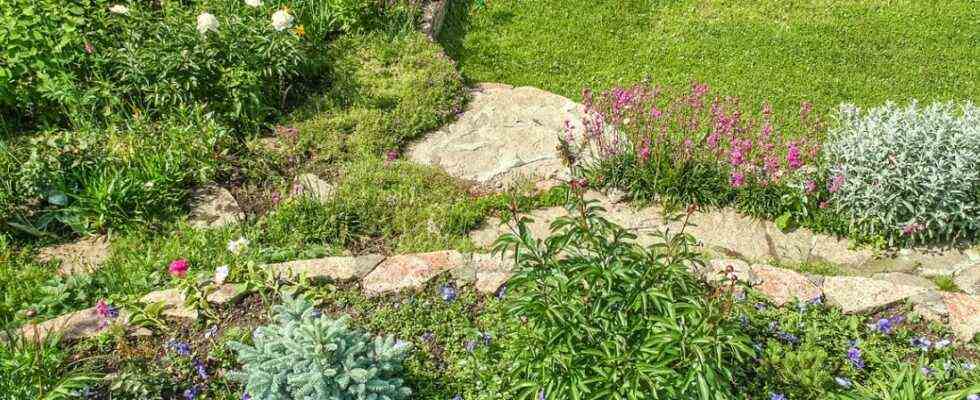Which plants to choose?
You should try to limit as much as possible the intervention needs on sloping areas, as this is always quite complex. You should therefore favor plants that require little maintenance, as well as those whose root system sinks deep into the soil to limit erosion. Prefer rather covering plants and those with evergreen foliage, they will prevent leaving the ground bare.
We suggest you discover a non-exhaustive list for your embankments.
- Shrub sage : it can flower for up to 9 months without stopping and without maintenance. Its many varieties allow them to be modulated as desired.
- Dogwood : it is a kind which brings together small trees with magnificent flowering and whose foliage offers beautiful colors during the autumn period.

- The rosebushes : whether they are ground cover or landscaped, they will find their place in sloping ground.
- St. John’s Wort : it is well known for its medicinal virtues. It is an easy to maintain plant that makes a very good ground cover. Its yellow flowers will bring light and color to your garden.

- Periwinkle : it has many other names like sorcerer’s violet, nasturtium, etc. It is an excellent ground cover to the point that it can become invasive. It is characterized by evergreen foliage and beautiful flowers which give its name to this characteristic blue: periwinkle blue.
- Daylily : it is a rustic plant which forms large colored clumps. It is a herbaceous perennial that forms large clumps.
- Iris : it is very popular with gardeners, because it gives very beautiful flowers that come in different colors.

- The creeping rosemary : it is an excellent ground cover which gives small light blue flowers. In addition to being hardy, it does not fear heat or drought and can thrive in poor soil, even rocky.
- Dwarf conifers : they have different shapes that can customize your slope. They are also available in different colors: from gold to icy blue through different greens, there is something for everyone. However, their growth is slow. It will therefore be necessary to take this into account when planning your slope.
- Creeping juniper : another evergreen conifer, but crawling this one.
- Sedum : it is a perennial which is part of the succulents. He likes the sun and does not fear drought.
- Star jasmine : it is a rustic plant whose evergreen foliage turns red in winter.

- Ivy : a climbing plant with evergreen foliage, which is not very demanding and will develop quickly. In ground cover, we will privilege the variety “Sulfur Heart”.

- Honeysuckle : this easy-to-grow plant has flowers that will delight you with their originality.
- The euchere : a robust plant that adapts to all gardens. It comes in different colors and offers an elegant flowering.

- Silver baskets or ibéris : it is a floor-covering perennial with evergreen green or silver foliage. In spring, they are covered with small white flowers which make them a very luminous plant.
- Grasses : they will bring lightness to your slope and allow it to be structured. It is therefore possible to choose several from the many varieties.
- The California Privet : a vigorous and hardy shrub, but which is only semi-evergreen.
How to plant on an embankment?
To install plants on your embankment, several solutions are available to you. Either way, don’t forget to water generously as soon as you install a plant. It’s best to plant a little more densely in order to get tight coverage quickly enough.
A first solution consists in proceeding as follows.
- In autumn, you need to start by preparing the embankment by shaving the vegetation in place.
- You can then proceed to a weeding using a weed knife or hoe.
- A second weeding should then be done a few weeks later.
- Then deposit boxes on the floor. They should be printed as little as possible. Be sure to hold them in place with large stones, bricks, or other heavy objects. This step deprives the weeds of light to prevent them from germinating.
- When April arrives, all you have to do is remove the boxes and scratching the face of the earth to loosen the earth.
- You can then install a tarpaulin on the ground, some are made of recyclable material, for example, burlap, linen, etc. If the slope is very steep or if the soil is very fine and sandy, the use of a tarpaulin is strongly recommended. Indeed, it will avoid the consequences of bad weather on the ground and it will prevent the growth of weeds for two years. This period gives you time to install the plants, respecting the necessary spaces for each of them, then allowing them to develop sufficiently. The tarp also helps prevent the soil from drying out too quickly.
Another solution is to vegetate the slope simply by stirring up the earth using a pickaxe. Once your soil is no longer compact, all you have to do is plant your plants. It is possible to group several specimens. To install your plants, you must dig a hole horizontally, clearing the soil in the direction of the slope. This way of proceeding will allow you to create a sort of small terrace on which the water can stagnate. Your plants will greatly appreciate this type of watering.
A final solution is to start with create terraces. They can be retained by stone walls, by wood, etc. Thus, you will avoid the problems linked to soil erosion. Once your different terraces have been created, all you have to do is install the plants of your choice on them.

